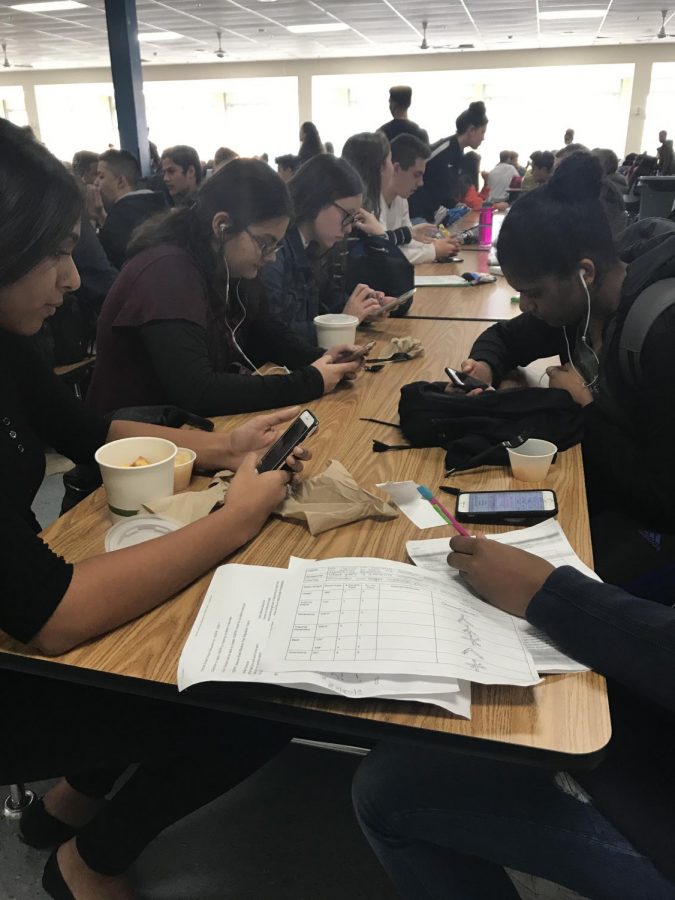Op-Ed: Cell phones changing the way we interact
Students are seen using phones at lunch instead of talking with each other.
January 9, 2018
With the invention of the cell phone, and the fact that they are seemingly in everyone’s hand, people are growing farther apart from each other because of a lack of human interaction.
According to the Pew Research Center, 15 percent of Americans 19-29 are dependent on their cell phones. Also, 91 percent of people ages 19-29 use social media throughout the day, while 47 percent use it as a way to avoid others. People are using cell phones and other technology to do the communication for them.
“Everything revolves around technology now and we’re losing sight of effective human interaction,” says Michael Boucher, school counselor. “[Kids are being raised in a society where texting is the] more appropriate way of communicating.”
Society is normalizing the use of cellphones while hanging out with friends, family, at work and school, and even when driving, despite laws and public service announcements to stop the behavior.
Technology is also disrupting people’s sleep schedules. Students as well as adults stay up late at night to text their friends or to use social media. The Sleep Help Foundation says that spending one and a half hours on a tablet in the evening makes people feel less sleepy. More than 85,000 teenagers used some type of technology before they go to bed, which results in them going to bed at a later time. The use of technology isn’t just affecting the ways humans interact. It’s affecting people’s health as well.
Throughout the school day, students use their phones to text their friends and family. English teacher Deb Stence, who has voiced her opposition to allowing students to use their phones during pass, says, “It’s [technology] interrupting kids in class.”
Instead of taking notes in class and listening to the teacher, students use their phones to check their social media or text friends, she said. If students find the class boring then they won’t bother to pay attention. They are drawn to the drama of social media. They find it more important than the curriculum that’s being taught.
“Students [are] so addicted to technology these days that they don’t really see anything else; they believe that everything is in their phone so they don’t have to rely on anyone else and [it] can basically cut off communication with everyone else,” says junior Megha Patel.
Just take a moment to look around in the hall. I did. During pass one day, I counted at least 15 students on their phone. Seven were using their phone while talking with their friend. Five were looking down at their phones, as if to avoid making eye contact with anyone. When my class started, I noticed four students using their phones without the teacher’s permission.
Many people have gotten to a point where they rely on technology and the internet for everything. Instead of looking in a book or asking for someone else’s help, the kids just think that the internet is the answer.
The reason for this is because the information is so easy to access for all generations. These days, anyone can access the internet at any time, day or place, which makes users use the internet more. It’s even become part of our lexicon, with the term “Google it.”
Students have become so reliant on technology that they rarely go to a teacher for help, let alone the library or the tutoring center.
Junior Lauren Pudelka says in her experience, “Usually teachers suggest to go online before asking for help.” Teachers are having students use the internet as a resource instead of having them look it up in a book. From here, students think that it is OK to go to the internet for answers instead of their teachers.
Senior Linda Thach says, “I do think my generation lacks human interaction because social media has caused us to go away from speaking face to face. Instead of saying ‘hello’ in person, it’s a ‘good morning streak’ snap on Snapchat.”
This doesn’t just happen in school with teenagers; it’s with adults as well. “When I’m out to eat, you’ll see parents on their phones at the dinner table instead of talking to one another,” Stence said.
Children are influenced by their surroundings, so if everyone in their surrounding is using their cell phones, then the children will think that using technology in public with other people is normal. This is leading to students using their phones during class.
“Kids are taught to use technology by teachers and parents. I think that some kids are just oblivious when they are on their phones and it make them antisocial sometimes,” Pudelka said.
This lack of human interaction will make it harder for teenagers to go out for a job interview or to talk with coworkers because they won’t know how to communicate. They won’t know how to talk to a stranger without having to look down at their phone for reassurance and comfort.
Boucher says, “You have to be able to hold a conversation and look someone in the eye and talk to them.” These days, teenagers and kids can’t even walk in the hallway without looking down at their phone to avoid speaking to someone.
“Humans are addicted to the feeling of connection and companionship,” says Cassidy Holmes, junior. “The idea that you have access to billions of pieces of information, as well as millions of unknown people, is addicting.”
People want to meet others and expand their group of friends. The only problem is that people are meeting each other online and when it comes to meeting in person, they won’t know how to communicate with each other.
“You can’t be judged instantly over text and you don’t have to respond right away like a normal conversation,” says Jarod Rodriguez, junior.
Communication through texting and social media is more normal than talking and meeting in person. It makes people feel more comfortable and gives them a bit more confidence knowing that they won’t have to think about what to say right on the spot.
For the past few years, technology has grown rapidly. There’s always a new device that grabs people’s attention “Our world is adapting to it,” Boucher said. Slowly as time goes on society will adapt to this new way of communicating but there will be a loss of human interaction. People will not know how to communicate with one another without having to use an electronic device.





















